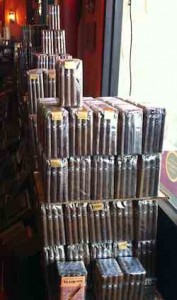 Of the three major cigar components – wrapper, binder and filler – it’s the wrapper leaves that readily present themselves for inspection when you’re making your purchase. Some industry experts claim that up to 75% of the flavor of a cigar comes from the wrapper – so be sure to get to know them well. “Kick the tires” so to speak of each new stogie you buy.
Of the three major cigar components – wrapper, binder and filler – it’s the wrapper leaves that readily present themselves for inspection when you’re making your purchase. Some industry experts claim that up to 75% of the flavor of a cigar comes from the wrapper – so be sure to get to know them well. “Kick the tires” so to speak of each new stogie you buy.
To pass muster, wrapper leaves should be thick and have an oily feeling. They should possess a smooth and uniform color, with small veining running throughout the leaf. The veins should be subtle, not prominent, and no blemishes should mar the leaf.
With all these tests to pass, it’s no wonder that wrapper leaves are carefully grown, aged and selected…and often a place where ‘unscrupulous’ manufacturers will try and skimp.
Wrappers are actually categorized by country of origin, but for most cigar smokers it’s easier to identify wrappers (and their flavor) by color than by country.
Quick Cigar Smoking Tip:
The darker the color, the greater the oil and sugar content of the wrapper
and the sweeter and stronger the flavor is likely to be.
Shade Grown Vs. Sun Grown Cigar Wrappers
What influences the color of wrappers? Cigar leaves that have no shading during growing develop a richer reddish hue with more robust flavors. Tobacco grown in the shade, often utilizing cheesecloth, produces pale brown/khaki-colored leaves.
Darker wrappers often come from high altitudes where exposure to the sun causes the leaves to produce oil as a form of self-protection. The sun also promotes the production of sugar through photosynthesis. Other dark wrappers may have spent more time at the tobacco plant and aged naturally, or they may have been fermented longer.
Types of Cigar Wrappers
Here’s what you should know:
• CLARO
Shade grown tobacco – protected from harsh light by large canopies — is usually light tan in color (claro). It offers a smooth smoke with a neutral flavor.
• CONNECTICUT BROADLEAF
From the Connecticut River Valley, this leaf is grown in the sun, which results in a coarser, darker, sweeter wrapper.
• CONNECTICUT SHADE
This wrapper leaf developed its distinctive golden hue under the protective shade of huge tents in the Connecticut River Valley. It is a direct descendent of the Hazelwood strain of Cuban seed.
• COLORADO
A reddish dark brown wrapper with an aromatic smell and rich, robust taste.
• COLORADO CLARO
Brands including Dominican Partagas use this medium brown wrapper.
• COLORADO MADURO
Slightly more aromatic than Maduro, the dark brown leaves of Colorado Maduro are found in many of the fine Honduran cigars, giving them a rich, deep flavor.
• DOUBLE CLARO (aka CANDELA or AMERICAN MARKET SELECT
Double Claro’s distinctive green/greenish brown color is achieved by picking the leaves early, before they reach full maturity. A rapid drying processreadies the leaf which has very little oil and a mild, almost bland flavor.
• ENGLISH MARKET SELECTION (EMS)/NATURAL
This term refers to a natural color wrapper usually light brown to brown in hue. It is different than claro or lighter shades, and maduro or darker shades. Most often sun grown, EMS leaves offer a smooth, but full-bodied flavor.
• HABANA 2000™
A relatively new wrapper made from Cuban Seed tobacco grown in Nicaragua.
• MADURO
Mexican wrappers are often Maduro, with more texture and veining than the lighter wrappers, with its deep dark brown leaves. They are often described as oily looking, with a stronger taste – sweet on the palate with a unique aroma.
• OSCURO
The strongest tasting of all wrappers, Oscuros tend to hail from Brazil, Mexico and Nicaragua. With a dark brown, almost black appearance, these leaves offer a potent flavor.
So the next time you smoke cigars, pay close attention to the wrapper and start finding your personal preference!
Recent Comments